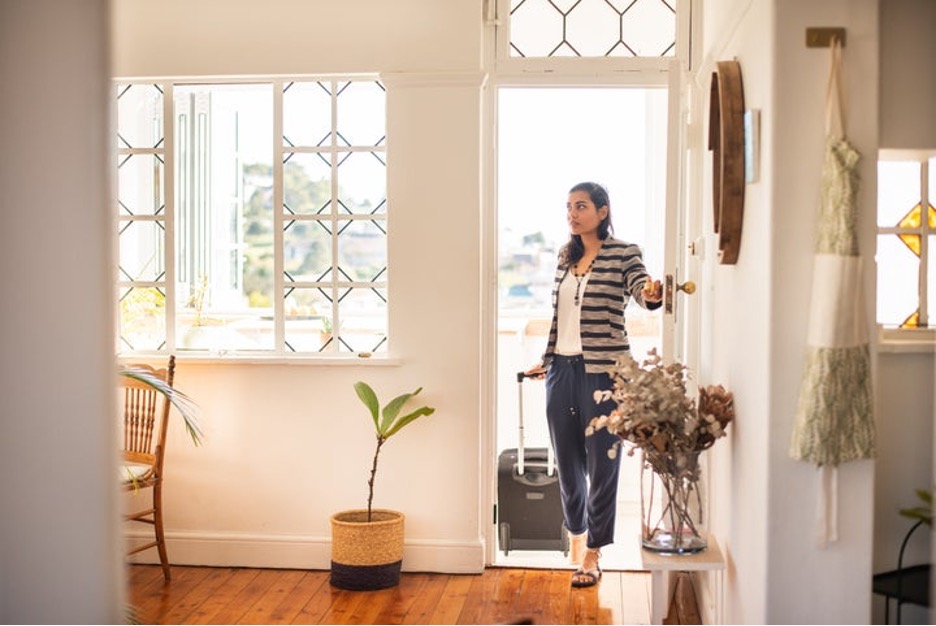Do these six things to protect yourself and minimize risks.

With platforms like Airbnb and Vrbo transforming how we travel, short-term vacation rentals have become the go-to choice for many travelers seeking privacy and space away from crowded hotels. The appeal is obvious—you get an entire home to yourself, often with kitchen facilities and local neighborhood charm that hotels simply can’t match.
But vacation rentals come with unique safety considerations that hotels don’t present. Unlike hotels with 24/7 front desk staff, security guards, and on-site managers, vacation rentals typically leave you on your own. If something goes wrong, there’s no immediate help just a phone call away to the front desk.
While staying at short-term rentals is generally safe, smart travelers take proactive steps to protect themselves. Here are six essential safety measures to implement the moment you arrive at your vacation rental.
- Scan for Hidden Cameras.
Your first priority should be checking for unauthorized recording devices. While platforms like Airbnb prohibit hidden cameras and require hosts to disclose any surveillance equipment, violations unfortunately occur.
Start by asking your host directly about any security cameras on the property. For your own peace of mind, conduct a thorough sweep of the rental space. Pay special attention to areas where you’d expect privacy—bedrooms, bathrooms, and living spaces.
Look for objects that seem out of place or have been tampered with. Common hiding spots include smoke detectors in bedrooms, light fixtures in bathrooms, alarm clocks, picture frames, and electrical outlets. Use your smartphone’s flashlight in darkened rooms to spot reflective camera lenses, and check for any unusual holes or openings in walls where small cameras could be concealed.
For tech-savvy travelers, network-scanning apps like Fing can detect unknown devices connected to the property’s Wi-Fi network. If you discover anything suspicious, document it immediately and contact your booking platform’s customer service.
- Secure Your Valuables Properly.
Protecting your belongings requires more strategy in a vacation rental than in a hotel room. Start by asking if the property includes a safe for storing passports, electronics, jewelry, and other high-value items. Many rentals provide safes, though you might need to bring your own padlock for extra security.
Consider investing in portable travel safes made with wire mesh between canvas layers and braided steel cables. These require bolt cutters to breach, making them excellent deterrents for opportunistic thieves.
Be mindful of what’s visible through windows. Avoid leaving valuable items in plain sight, especially electronics, cameras, or designer bags. If you’re staying in a ground-level unit or one with large windows, this becomes even more critical.
Don’t forget about your vehicle if you’re driving. Remove all belongings from your car, including anything in the trunk that might be visible. Even items that seem worthless to you could attract break-in attempts.
- Verify Safety Equipment.
Fire safety and carbon monoxide detection are non-negotiable safety requirements. Check every floor of the rental for working smoke and carbon monoxide detectors. While booking platforms allow hosts to indicate whether these devices are present, you need to verify they’re actually functional.
Test each detector to ensure it’s working properly. Look for the green light or other indicators that show the device is operational. If you’re particularly cautious, consider traveling with portable smoke and carbon monoxide detectors for extra protection.
Don’t assume these devices are working just because they’re present. Batteries die, and some hosts may not stay on top of maintenance. Your life could depend on these devices functioning properly.
- Learn the Layout and Plan Your Escape.
Take time to walk through the entire property and understand its layout. Locate all doors and windows, and test them to understand which are functional exits. Many properties have doors that appear to be exits but are actually bolted shut or lead to unsafe areas.
Create a mental emergency escape plan. Identify at least two ways to exit each room you’ll be sleeping in. Find the first aid kit and fire extinguisher, and check that the extinguisher is properly charged and functional.
Pay special attention to entry points that could be used by intruders. Unlike hotel rooms with typically just one entry point, vacation rentals often have multiple doors, windows, and access points. Test all locks on doors and windows to assess their security.
If traveling with children, scan for potential hazards like sharp objects, unsecured furniture, or dangerous items within reach. Ensure televisions and heavy objects are properly secured.
Explore the surrounding neighborhood as well. Before your arrival, identify the locations of the nearest police station, fire station, hospital, and pharmacy. Having this information readily available could save precious time in an emergency.
- Add Extra Security Measures.
Even if the property has existing security features, consider adding your own protective measures. Portable motion detectors are inexpensive and can alert you to someone attempting to breach doors or windows during the night.
Door stop alarms provide an additional layer of security, especially for ground-level accommodations or properties with numerous windows. These small devices wedge under doors and emit loud alarms if someone tries to enter.
Portable door and window locks can supplement existing security hardware. These temporary additions give you control over your safety without modifying the property.
Check whether the property already has outdoor sensor lights and alarm systems. Even if present, your additional security measures provide backup protection and peace of mind.
- Enable Location Tracking and Emergency Planning.
Always inform trusted contacts about your whereabouts when traveling, especially if you are going solo. Share your rental address and reservation confirmation with family or friends.
Enable location sharing through apps like Find My Friends so your emergency contacts can track your whereabouts in real-time. This feature can be invaluable if something goes wrong and you can’t communicate your location.
Establish your emergency communication plan before you need it. Determine whether the property has reliable Wi-Fi and cell service. Know who you can call back home for help, and ensure you have ways to communicate if you don’t speak the local language.
Research local emergency numbers and procedures. While 911 works in the United States, other countries have different emergency contact systems you’ll need to know.
Note: Research Before You Book.
Smart vacation rental safety actually begins before you travel. Choose properties from experienced hosts with excellent ratings and reviews. Read guest reviews carefully, paying attention to any safety-related comments or concerns.
Research the neighborhood using tools like CrimeMapping.com to understand local safety concerns. Google Street View helps you see exactly what the area and property entrance look like before you arrive.
Consider your specific safety needs based on your identity and circumstances. Solo travelers, families with children, LGBTQ+ travelers, and people of color may want to research additional safety factors specific to their situations.
When possible, book entire properties rather than individual rooms within shared accommodations. Sharing space with unknown individuals increases potential security risks.
Twist’s Take: While no vacay rental is completely risk-free, following these six safety measures can dramatically reduce your chances of encountering problems.
